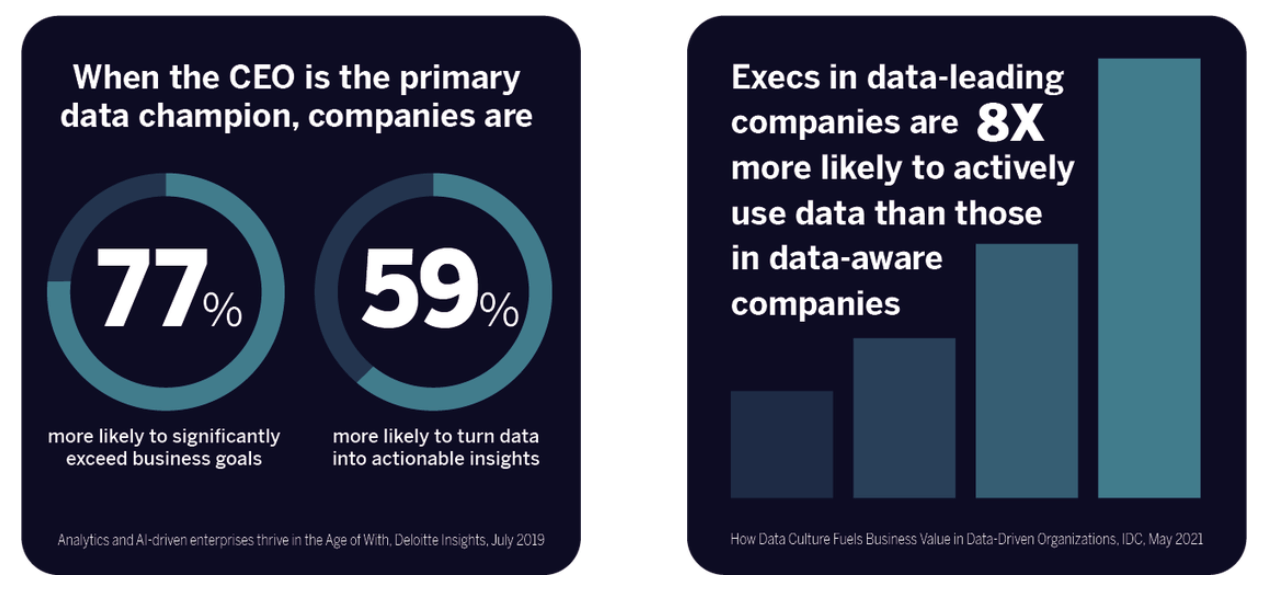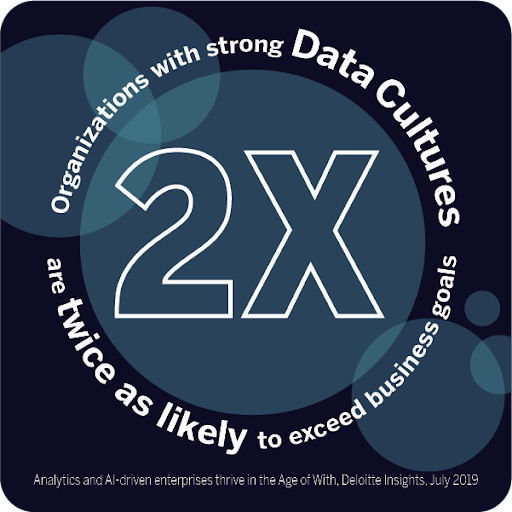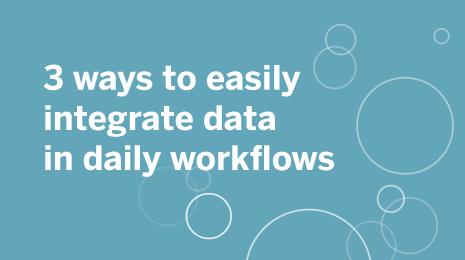Leaders, accelerate your data-driven journey with community
Editor's note: This article appeared in Forbes.
In the journey to become data-driven, even data-leading, organizations traditionally viewed technology as the golden ticket. But adopting the right analytics platform isn’t enough: The ultimate accelerator of your data investments is community. That’s not hyperbole—throughout my career as a data leader, I’ve seen the power of community play out time and time again in my own organization and with customers and partners across industries and geographies.
My eight years at Tableau have focused on helping people be successful with data, from quarterbacking go-to-market efforts to highlighting customer perspectives and successes, and community is central to that work. I now have the privilege of leading what we lovingly refer to as the world’s greatest data community. The Tableau Community has taught me countless lessons, the most important being: When leaders nurture a supportive, collaborative data community, it strengthens and benefits their organization’s Data Culture, yielding successful business outcomes.
Leaders, from line-of-business leads to the C-suite, here’s what you need to know about data communities—and what they mean for the ROI of your analytics technologies and investments.
Data-driven organizations shift from negative perceptions to viewing data as a positive, empowering differentiator. And they enable that cultural sea change with community.
Better together: Data Culture + data communities
Successful data initiatives combine technology, culture, and people to create a lasting Data Culture that weaves data-driven decision making into the fabric of an organization. In a thriving Data Culture, everyone, regardless of role or title, relies on data to problem solve and inform decisions.
My predecessor, Stephanie Richardson, summed it up nicely: “When we think of Data Culture, it really is about bringing people along for that transformation, and not only enabling them with the right technology, but also with the skills, the support, the community, the learning—all of those things that go with trying to change someone’s behavior.”
Culture is the biggest driver of success—and the biggest barrier. According to a 2019 Deloitte survey, organizations with strong Data Cultures are two times more likely to exceed their business goals, yet a full 95% of organizations surveyed cited cultural challenges as a blocker.
At the root of those behavioral and cultural changes is a mindset shift. Data-driven organizations successfully shift from negative perceptions—data is daunting, overwhelming, confusing, messy, incomplete, and disjointed—to viewing data as a positive, empowering differentiator. And they enable that cultural sea change with community.
Data communities inspire. They bring people together to accelerate adoption, instill new behaviors, and drive action around arguably our most important resource—data. They foster engagement and learning through collaboration and sharing. They build data skills and a common understanding of the language of data. They lead to iteration and innovation, which lead to growth and success. They allow people to try, fail, learn, improve, and celebrate, backed by a supportive community.
Ideally, organizations build a community of enablement where data community and Data Culture grow in parallel, says Data Leadership Collaborative (DLC) advisor and Snowflake EMEA Senior Evangelist Eva Murray, who quite literally wrote the book on building inspired analytics communities. In that environment, a community grows across the business, welcoming people from different departments and functions, spreading like tentacles into every corner of the organization. Those tentacles enable a two-way flow of information, bringing the needs of the business back to the community and funneling the community’s learnings and practices into the organization’s operational heartbeat.
What you need to know about data communities
Let’s be frank: Building a Data Culture isn’t easy. It requires a clear vision and a holistic view of the complexities of operating in a digital world. It demands a baseline of data literacy, technology that’s accessible to everyone, and that all-important mindset of data as an enabler, not a detractor. As Tableau Lead Solution Engineer Candra McRae says: “Having data is one thing. Actually putting it to work for you and your organization is another.”
That’s where community programs—both grassroots efforts from the bottom up and peer networks for business and data leaders—can help overcome obstacles.
Communities are good for people—and that’s good for business
Communities provide the framework for internal and external peer-to-peer collaboration that builds up organizations, their people, and their Data Culture.
New perspectives and approaches
Communities offer an outlet for sharing, learning, support, and inspiration to guide you and your teams along the path to a thriving Data Culture. External communities allow you to look beyond the walls of your organization to see what others are doing, reveal blind spots, learn from their wins and losses, and understand how you stack up. Conversely, internal communities help teams look within to break down silos and share information between functions to answer key business questions and solve organizational challenges.
A peer-to-peer community for leaders, such as the Data Leadership Collaborative, provides a forum for leaders to get and give unfiltered takes on what works and what doesn’t and learn from the hard-won experiences of others.
Skills development and problem solving
According to Murray, successful communities are grounded in skill sharing and generosity to facilitate collaboration, learning, and engagement.
In her role as a solution engineer, McRae helps people at all levels of the business make the most of their analytics platforms. She’s found that community can help answer critical questions for everyone from data analysts to the C-suite, such as:
- Analysts: How can I build this dashboard better? Do my job faster?
- Business and domain experts: What information can I quickly and easily access to inform better decisions? How can I grow my analytical skills? Partner with analysts to improve centralized data sources and dashboards? Self-serve my own data insights?
- People managers: How can I make my team successful? Build their skills? Attract and retain talent?
- Executives and leaders: How can I transform how we as an organization use data to drive better business outcomes? How do I maximize ROI on the tools we’ve already invested in? Am I behind our competitors or missing out?
By building data skills and literacy, communities reduce time on task. And while time savings are beneficial, it’s what people do with them that really matters. Those extra hours become time spent innovating new solutions, testing and improving processes, and finding insights, faster.
Tableau Community member turned solution engineer Mark Bradbourne has experienced these benefits firsthand.
“Let’s say someone’s development time goes from 40 hours to eight. They’ve gained four days of efficiency, so what else can they now do?” says Bradbourne. “And that turn happens fast,” he adds. After three months of participating in a weekly community project, #MakeoverMonday, Bradbourne got “really fast and effective. I could quickly find data stories on data sets I’d never seen before.”
Murray believes it’s on leaders to better communicate that value. “Your job is not to copy and paste from Excel to PowerPoint,” she says as an example. “Your job is to apply your knowledge, have conversations, tease out the problems and find the gold nuggets in the data. You can’t do that if you spend 90% of your time wrangling data into place.”
Improved morale and employee retention
Communities are good for morale—and retention. They offer skills and career growth opportunities that help people feel engaged and supported and see the value of their roles, all things that build organizational loyalty. LinkedIn Learning’s 2021 Workplace Learning Report found that learning together boosts engagement by 30x, and 92% of learning and development professionals agree that community-based learning helps foster workplace belonging. The same report found that engaged learners are more inclined to take part in internal mobility programs—which double employee retention.
Plus, they can infuse much-needed fun into the mix. We’ve seen many organizations spin up their own versions of Iron Viz, Tableau’s annual data visualization competition, styled after Iron Chef. As Tableau-customer Whole Foods Market grew its internal data community, the supermarket chain paired trainings, data doctor sessions, and regular video tips with weekly contests to scale to more than 18,000 active internal users of the analytics platform.
Your support can make or break its success

“It takes leadership at the top to really make that commitment to instill Data Culture across the entire organization,” says Tableau Vice President of Customer Strategy and Programs Jenn Day. “It requires support from every manager, including driving measurements in performance goals. It means always bringing data into the conversation when making key business decisions. It involves having dashboards available to the whole organization and using them on a regular basis.”
Walk the walk
It’s up to you to signal that data communities—and, by extension, Data Culture—are important. Show up and participate. Give praise and recognition. Encourage sharing and collaboration. Routinely ask your internal communities what they need to maintain and grow. Use data in your day-to-day and expect your teams to do the same. Ask people to bring data to meetings, and dig into the data when making decisions.
Create space
Invest in your teams by giving people time to spend on community activities and personal development. Publicly recognize the value of time spent engaging in user groups, keeping abreast of techniques and best practices, and participating in skill-building challenges. Don’t schedule that important meeting at the same time as a standing user group. And don’t expect people to build their data skills solely on their own time.
Community isn’t built in a day: Just get started
All of the community experts I spoke with emphasized the importance of starting somewhere. “Start small and build,” says McRae. “Ask: ‘What’s my next step now?’”
Building a thriving data community is a long game. “People want to see instant ROI,” Bradbourne told me. “It doesn’t work that way. It’s very much the planting of a seed.”
So plant that seed. The longer community is nurtured, the more benefits you’ll see as it grows and evolves alongside the business. The bottom line, according to Bradbourne: “The only thing to avoid is not trying anything at all.”
Now it’s your turn. Consider these two steps:
- Support, sponsor and make space for data communities at your organization with the Data Communities Toolkit. Encourage your teams to create or join a group like the Tableau Community.
- Find your community of like-minded leaders. Get started at the Data Leadership Collaborative or learn how to create your own data leadership committee.
Special thanks to Eva Murray, Candra McRae, and Mark Bradbourne for contributing their expertise and insights to this article.
Larissa Amoroso, senior director of the Tableau Community, has been with Tableau for eight years. She is responsible for fostering collaboration, inspiration, and engagement within the world’s greatest data community. With a passion for highlighting the voices of customers and building communities, Larissa has more than 15 years of experience leading cross-functional teams to create engaging experiences that inspire customers and drive action.
Related Stories
Subscribe to our blog
Get the latest Tableau updates in your inbox.








